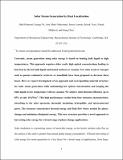| dc.contributor.author | Ghasemi, Hadi | |
| dc.contributor.author | Marconnet, Amy Marie | |
| dc.contributor.author | Yerci, Selcuk | |
| dc.contributor.author | Miljkovic, Nenad | |
| dc.contributor.author | Chen, Gang | |
| dc.contributor.author | Ni, George Wei | |
| dc.contributor.author | Loomis III, Robert James | |
| dc.date.accessioned | 2015-03-12T15:25:33Z | |
| dc.date.available | 2015-03-12T15:25:33Z | |
| dc.date.issued | 2014-07 | |
| dc.date.submitted | 2014-04 | |
| dc.identifier.issn | 2041-1723 | |
| dc.identifier.uri | http://hdl.handle.net/1721.1/95979 | |
| dc.description.abstract | Currently, steam generation using solar energy is based on heating bulk liquid to high temperatures. This approach requires either costly high optical concentrations leading to heat loss by the hot bulk liquid and heated surfaces or vacuum. New solar receiver concepts such as porous volumetric receivers or nanofluids have been proposed to decrease these losses. Here we report development of an approach and corresponding material structure for solar steam generation while maintaining low optical concentration and keeping the bulk liquid at low temperature with no vacuum. We achieve solar thermal efficiency up to 85% at only 10 kW m[superscript −2]. This high performance results from four structure characteristics: absorbing in the solar spectrum, thermally insulating, hydrophilic and interconnected pores. The structure concentrates thermal energy and fluid flow where needed for phase change and minimizes dissipated energy. This new structure provides a novel approach to harvesting solar energy for a broad range of phase-change applications. | en_US |
| dc.description.sponsorship | United States. Dept. of Energy. Office of Basic Energy Sciences (Energy Frontiers Research Center. Award DE-SC0001299) | en_US |
| dc.description.sponsorship | United States. Dept. of Energy. Office of Basic Energy Sciences (Energy Frontiers Research Center. Award DE-FG02-09ER46577)) | en_US |
| dc.description.sponsorship | United States. Air Force Office of Scientific Research (FA9550-11-1-0174) | en_US |
| dc.description.sponsorship | Masdar Institute of Science & Technology - MIT Technology & Development Program | en_US |
| dc.description.sponsorship | Natural Sciences and Engineering Research Council of Canada | en_US |
| dc.language.iso | en_US | |
| dc.publisher | Nature Publishing Group | en_US |
| dc.relation.isversionof | http://dx.doi.org/10.1038/ncomms5449 | en_US |
| dc.rights | Article is made available in accordance with the publisher's policy and may be subject to US copyright law. Please refer to the publisher's site for terms of use. | en_US |
| dc.source | Chen, Gang | en_US |
| dc.title | Solar steam generation by heat localization | en_US |
| dc.type | Article | en_US |
| dc.identifier.citation | Ghasemi, Hadi, George Ni, Amy Marie Marconnet, James Loomis, Selcuk Yerci, Nenad Miljkovic, and Gang Chen. “Solar Steam Generation by Heat Localization.” Nature Communications 5 (July 21, 2014). | en_US |
| dc.contributor.department | Massachusetts Institute of Technology. Department of Mechanical Engineering | en_US |
| dc.contributor.approver | Chen, Gang | en_US |
| dc.contributor.mitauthor | Ghasemi, Hadi | en_US |
| dc.contributor.mitauthor | Marconnet, Amy, Marie | en_US |
| dc.contributor.mitauthor | Yerci, Selcuk | en_US |
| dc.contributor.mitauthor | Miljkovic, Nenad | en_US |
| dc.contributor.mitauthor | Chen, Gang | en_US |
| dc.contributor.mitauthor | Ni, George Wei | en_US |
| dc.contributor.mitauthor | Loomis III, Robert James | en_US |
| dc.relation.journal | Nature Communications | en_US |
| dc.eprint.version | Author's final manuscript | en_US |
| dc.type.uri | http://purl.org/eprint/type/JournalArticle | en_US |
| eprint.status | http://purl.org/eprint/status/PeerReviewed | en_US |
| dspace.orderedauthors | Ghasemi, Hadi; Ni, George; Marconnet, Amy Marie; Loomis, James; Yerci, Selcuk; Miljkovic, Nenad; Chen, Gang | en_US |
| dc.identifier.orcid | https://orcid.org/0000-0003-4337-4187 | |
| dc.identifier.orcid | https://orcid.org/0000-0002-3968-8530 | |
| dc.identifier.orcid | https://orcid.org/0000-0001-7506-2888 | |
| dspace.mitauthor.error | true | |
| mit.license | PUBLISHER_POLICY | en_US |
| mit.metadata.status | Complete | |
